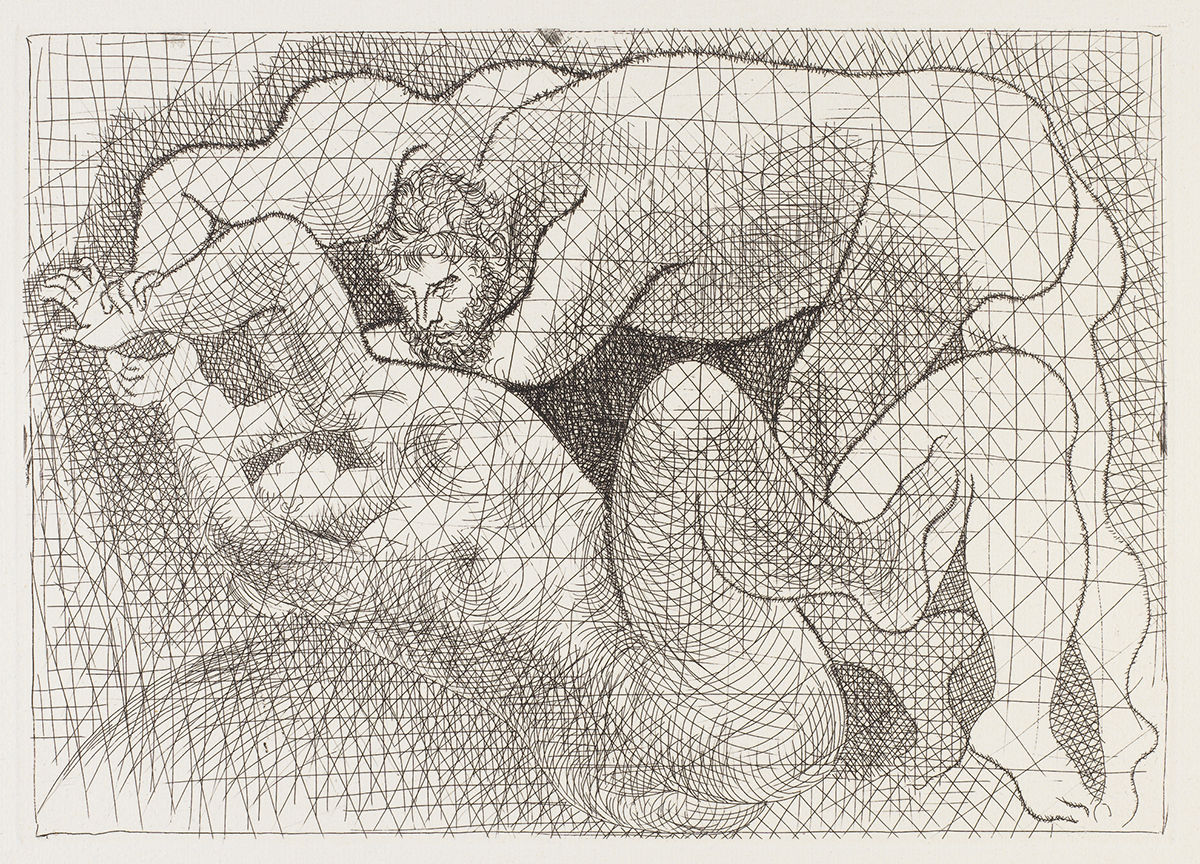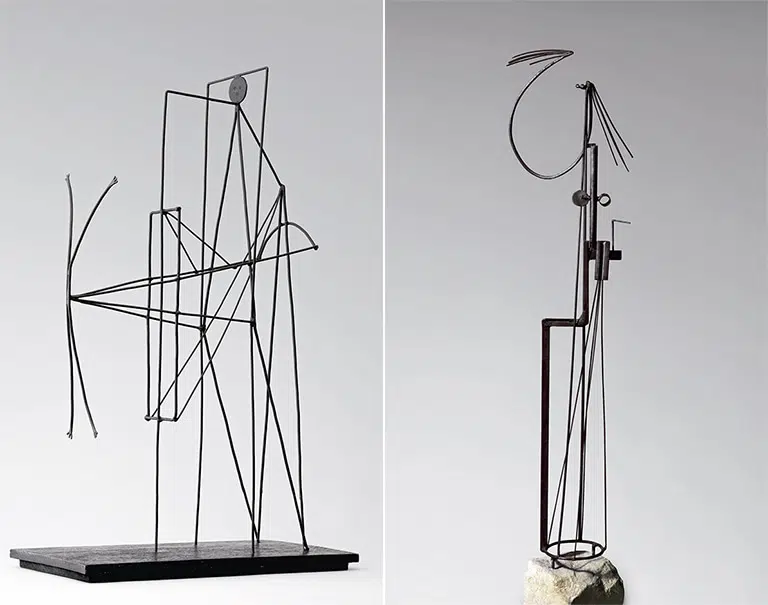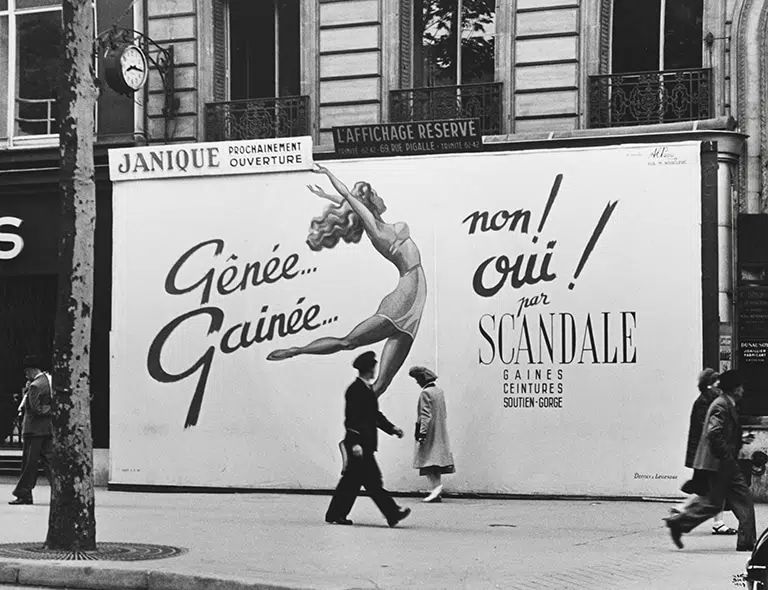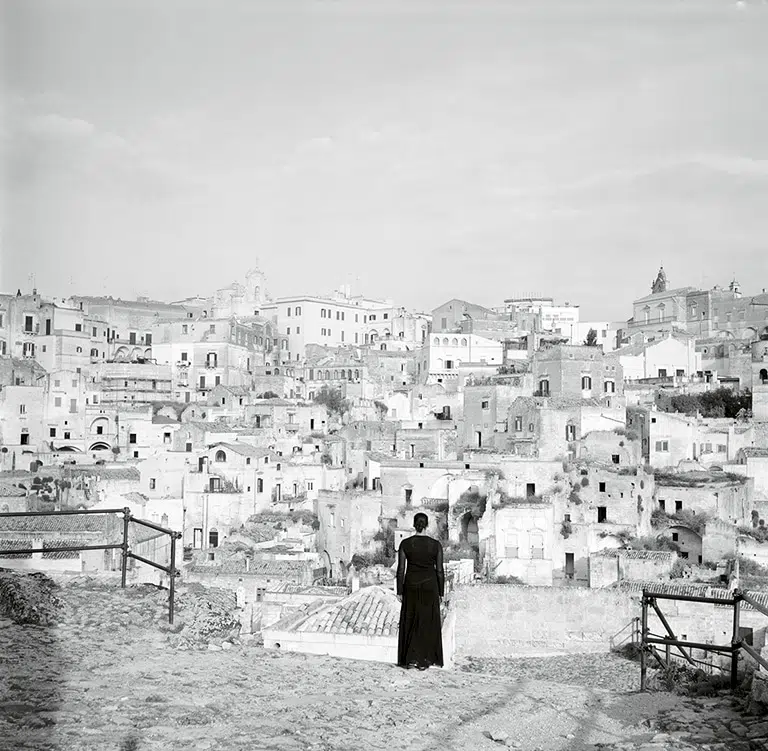Violación

Pablo Picasso
Violación, 09.07.1931
Suite Vollard – Miscelánea
© Pablo Picasso: Sucesión Pablo Picasso / VEGAP, Madrid, 2021
© Fundación MAPFRE COLLECTIONS
Technique
Copper, etching on Montval laid paper
Dimensions
Without a frame: 22,1 x 31,2 cm
With frame: 34 x 44,5 cm
Inventory
FM001614
Description
The Suite
Ambroise Vollard met Picasso on the Malaga-born artist’s second trip to Paris in 1901. From this point onwards, Vollard began to regularly acquire the artist’s works, above all in his blue and rose period. Picasso began to paint him every time he visited him, with the idea of creating a series of paintings but the art dealer’s sudden death in a road accident in 1939 interrupted this project and Picasso only managed to make three portraits which today complete the ninety seven etchings known as the Suite Vollard. The series has 100 copper engravings made between 1930 and 1937 with varying themes and which do not have a precise chronological order. Picasso employed a wide range of techniques in these etchings: burin, etchings, aquatint, gouache, drypoint and even the combination of several different techniques.
In addition to the three portraits of Vollard, dated in 1937, we also find 27 diversely-themed plates, five dedicated to the Batalla del amor (Battle of love) (1933); four on Rembrandt (7 to 31 January 1934); 46 with the theme of El taller del escultor (The sculptor’s studio) (41 made between March and the 5 May 1933 and 5 between January and March 1934); 11 on the Minotauro (Minotaur) (17 May to 18 June 1933) and 4 more on the theme of the Minotauro ciego (blind Minotaur) (22 September to 23 October 1934).
The vast majority of the subjects that feature in the Suite Vollard are present throughout Picasso’s work, but looking through them again transforms them and lends them a fuller meaning.
Females
The sculptor’s gaze, which relates to that of the viewer/sculptor contemplating the work from the outside, becomes the protagonist. Women talking, nude or seated. The models always seem removed from the events occurring around them. Sometimes they are involved in some kind of an activity, such as in En el baño (In the bath) and in other prints they are watching drowsily.
The motifs always reveal intimate and toilette scenes which were often depicted by Cézanne, Degas and Toulouse-Lautrec at the end of the 19th century and the beginning of the 20th century.
However, Degas and Toulouse-Lautrec’s toilette scenes are more private and intimate: they have their backs to us, far removed from our gaze, they are washing a basin or drying their hair. Picasso’s scenes are set in a more classical atmosphere and are not in any way anecdotal. In his scenes there are no towels, no basins, and we are unable to locate the exact space the women occupy; in this sense this Malaga-born artist’s work is more akin to that of Cézanne’s bathers.
Baer, Brigitte, «Creatividad, mitos y metamorfosis en los años treinta», en Picasso Clásico, cat. exp., Málaga, Junta de Andalucía, 1992, pp. 111-153
—, «A principios de 1933. El escultor y su escultura, y después la modelo», en Picasso erótico, cat. exp., Barcelona, Museu Picasso, 2001, pp. 100‑116
—, «Un monólogo interior», en Picasso, Suite Vollard y Minotauromaquia, cat. exp., [Madrid], Sociedad Estatal para las Exposiciones Internacionales, 2003, pp. 25‑39
—, «La mano, la manera de trabajar», en Picasso, Suite Vollard y Minotauromaquia, cat. exp., [Madrid], Sociedad Estatal para las Exposiciones Internacionales, 2003, pp. 77‑103
Barr, A. H., Picasso: Fifty years of his art, Nueva York, The Museum of Moderm Art, 1946
Bloch, Georges, Picasso: Catalogue de l’oeuvre gravé et litographié 1904‑1967, Berna, Kornfeld et Klipstein, 1968
Boggs, Jean Sutherland, Picasso and the Vollard Suite, cat. exp., Otawa, National Gallery, 1971
Blunt, Anthony y Phoebe Pool, Picasso: The Formative Years, Londres, Studio Books, 1962
Bozal, Valeriano, Los primeros 10 años. 1900‑1910, los orígenes del arte contemporáneo, Madrid, Visor, 1991
— «Picasso clásico. La pintura del viejo», en El Realismo en el arte contemporáneo, Madrid, Fundación Cultural Mapfre Vida, 1999, pp. 29‑54
— Picasso, Madrid, Electa, 1999.
— Picasso en Boisgeloup, con Marie-Thérèse y en torno a L’homme au mouton, Madrid, Museo de Arte Reina Sofía, 2006
Brassaï, Conversaciones con Picasso, Madrid, Turner, 2002
Breton, André, «Picasso Dans son élément», en Minotaure, París, 1 (1933), pp. 21‑22
Cabanne, Pierre, El siglo de Picasso. Vol II, Madrid, Ministerio de Cultura, 1982
Calvo Serraller, Francisco «La parábola del escultor», en Suite Vollard, Madrid, Instituto de Crédito Oficial, 1991, pp. 25‑49
—, «Revueltas modernas del clasicismo», en Picasso Clásico, cat. exp., Málaga, Junta de Andalucía, 1992, pp. 27‑67
Carmona, Eugenio, Las metamorfosis de la fiesta. El mito taurino en la obra gráfica de Picasso, Málaga, Urania, 1988
Carrete Parrondo, Juan, «Picasso, la Suite Vollard y las técnicas del grabado» en Picasso, Suite Vollard, Madrid, Turner, ICO, 1991, pp. 69‑79
Clair, Jean, Lección de abismo. Nueve aproximaciones a Picasso, Madrid, La Balsa de la Medusa, Antonio Machado Libros, 2008
Cohen, Janie, «El diálogo de Picasso con el arte de Rembrandt», en Rembrandt en la memoria de Goya y Picasso, cat. exp., [Madrid], Fundación Bancaja, Fundación Carlos de Amberes, Ibercaja, 1999, pp. 99‑145
Daix, Pierre, Picasso, Nueva York, Praeger, 1965
— Picasso creador, Buenos Aires, Atlántida, 1987
— «El arlequín con espejo, Sara Murphy y el fin del clasicismo de Picasso», en Picasso, 1923: Arlequín con espejo y La flauta de Pan, cat. exp., Madrid, Fundación Colección Thyssen-Bornemisza, 1995, pp. 15‑25
— Dictionaire Picasso, París, Robert Laffont, 1995
Derouet, Christian, Juan Gris, cartas, dibujos 1915‑1921, Valencia, IVAM, 1991
Friedlaender, Walter, De David a Delacroix, Madrid, Alianza, 1989
Gállego, Julián, Picasso, Suite Vollard, cat. exp., Madrid, Fundación Juan March, 1996
Geiser, Bernhard y Brigitte Baer, Picasso, peintre-graveur, Berna, Chez l’auteur, 1933‑1996, 8 vol
Gilot, Françoise, Mi vida con Picasso, Barcelona, Bruguera, 1965
González, Julio, «Picasso Sculpteur», en Cahiers d`Art, París, X/6 (1936)
Hilton, Timothy, Picasso, Destino, Barcelona, 1997
Kahnweiler, Daniel-Henry, Juan Gris: vida, obras y escritos, Barcelona, Quaderns Crema, 1995
Leiris, Michel, Picasso and the Human Comedy: a suite of 180 drawings, Nueva York, Random House, 1954
Mallén, Enrique, La sintaxis de la carne, Pablo Picasso y Marie-Thérèse Walter, Santiago de Chile, Ril, 2005
Muñoz Molina, Antonio, «Teoría del verano de 1923», en Picasso, 1923: Arlequín con espejo y La flauta de Pan, cat. exp., Madrid, Fundación Colección Thyssen‑Bornemisza, 1995, pp. 27‑37
— «El Minotauro y la doncella», El País, Babelia, Madrid, 28 de marzo de 2009
Nietzsche, Friedrich, El nacimiento de la tragedia, Madrid, Edaf, 1998
Ors, Eugenio d’, Glosari, Barcelona, Edicions 62, 1992
Ovidio, Metamorfosis, Barcelona, Bruguera, 1982, (introducción, traducción y notas de Antonio Ruiz Elvira)
Penrose, Roland, Picasso, su vida y su obra, Barcelona, Argos Vergara, 1981
Pi, Jaques Jessica, Picasso en Gosol, 1906: un verano para la modernidad, Madrid, Antonio Machado Libros, 2007
Picasso, Pablo, «Antología de textos», en Centenario Picasso, Madrid, 1983, pp. 29‑30, (número monográfico de El Socialista)
Picasso, 1881‑1981, Madrid, Taurus, 1981
Picasso clásico, cat. exp., Málaga, Junta de Andalucía, 1992
Picasso erótico, cat. exp., Barcelona, Museu Picasso, 2001
Picasso íntimo, cat. exp., Zaragoza, Ibercaja, 1993
Picasso, Minotauro, cat. exp., Madrid, Museo Nacional Centro de Arte Reina Sofía, 2000
Picasso, Suite Vollard, Madrid, Turner, ICO, 1991
Picasso, Suite Vollard: The Vollard Suite of 100 etchings 1930‑1937, London, Fine Arts, 1973, (introducción de Werner Spies)
Picasso, Suite Vollard, Valencia, Bancaja, Obra Social, 1994
Picasso, Suite Vollard y Minotauromaquia, cat. exp., [Madrid], Sociedad Estatal para las Exposiciones Internacionales, 2003
Picasso, tradición y vanguardia, cat. exp., Madrid, Museo del Prado, Museo Nacional Centro de Arte Reina Sofía, 2006
Picasso’s Vollard Suite, Londres, Thames & Hudson, 1977, (introducción de Hans Bolliger)
Rembrandt en la memoria de Goya y Picasso: obra gráfica, cat. exp., [Madrid], Fundación Bancaja, Fundación Carlos de Amberes, Ibercaja, 1999
Romero Solís, Pedro, El Minotauro: Suite Vollard, Madrid, ICO, 1992
Rubin, William, «The Pipes of Pan: Picasso’s Aborted Love Song to Sara Murphy», en Artnews, 93/5, mayo 1994, pp. 138‑147
Spies, Werner y Christine Piot, La escultura de Picasso, Barcelona, Polígrafa, 1989
Vázquez de Parga, Ana, «Introducción», en Picasso Suite Vollard y Minotauromaquia, cat. exp., [Madrid], Sociedad Estatal para las Exposiciones Internacionales, 2003, pp. 15‑23
Zervos, Christian, Cahiers d’Art, París, VII/10 (1933)
— «Conversation avec Picasso», en Cahiers d’Art, París, X/7‑10 (1935), pp. 173‑178.




